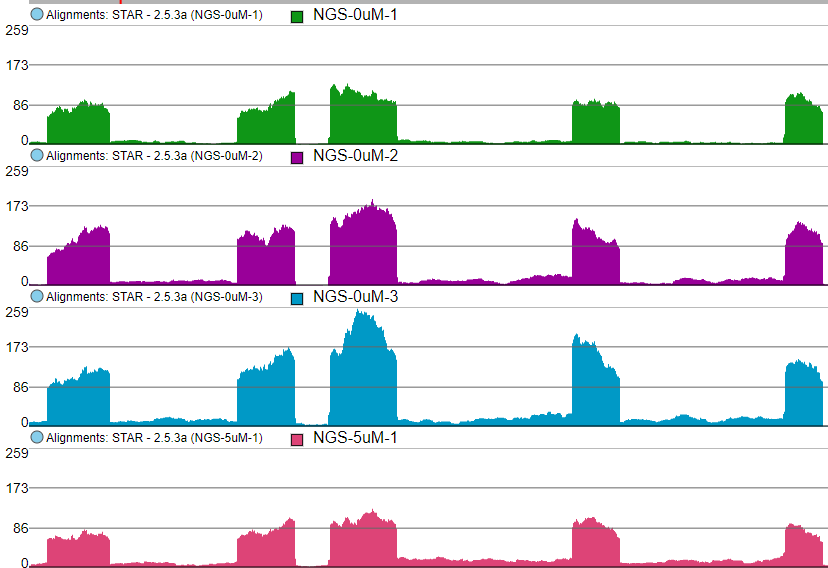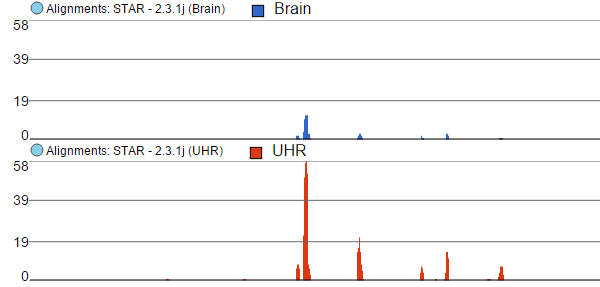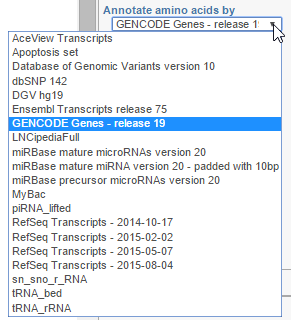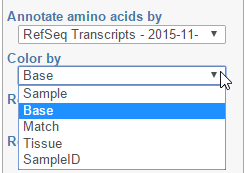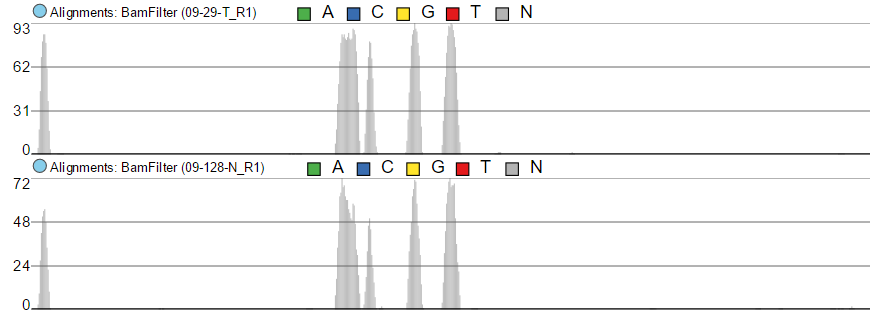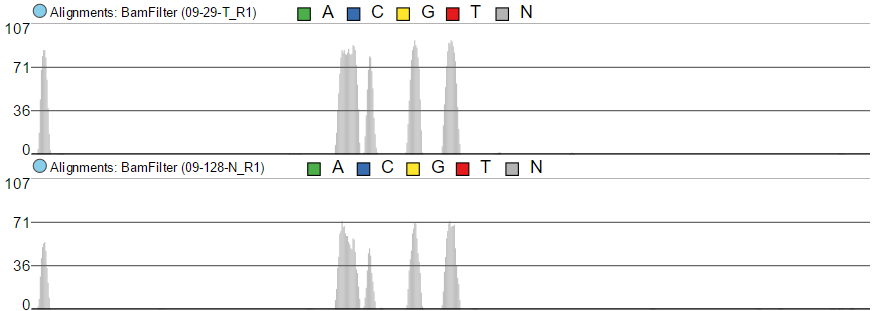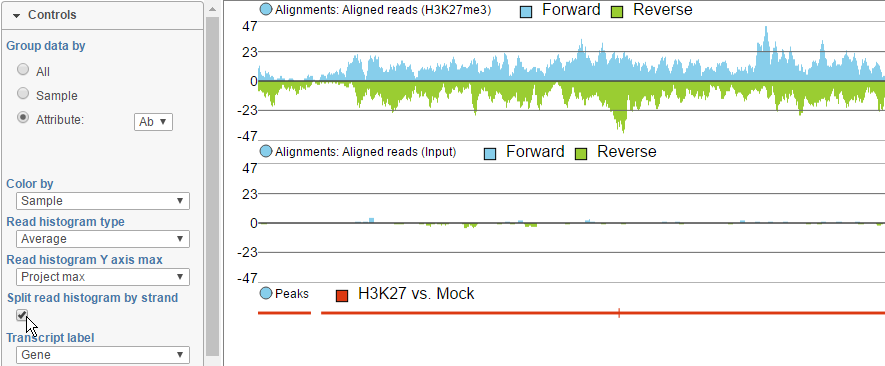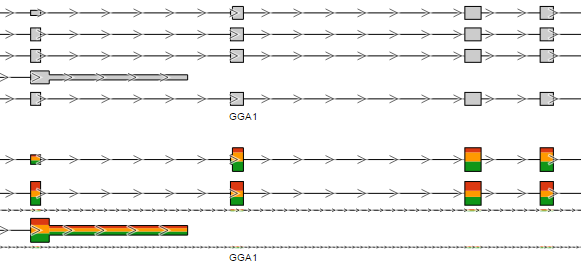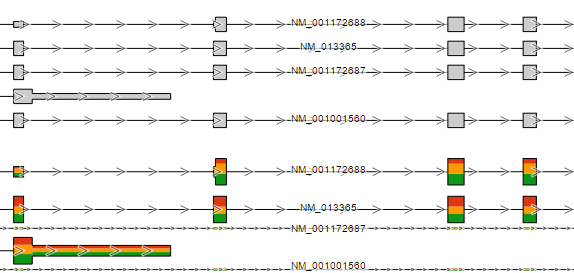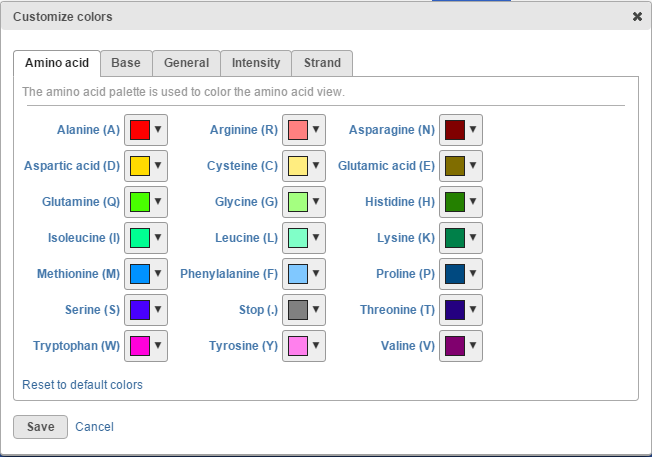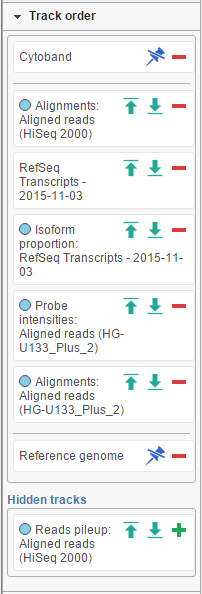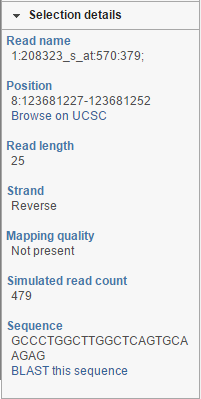Page History
...
| Numbered figure captions | ||||
|---|---|---|---|---|
| ||||
Group data by
The first option, Group data by, specifies the number of Alignments tracks (Figure 2). All will result in only one track, with all the samples on it. Sample creates one track per sample, while Attribute produces one Alignments track per level of the Attribute (i.e. one track per group).
...
| Numbered figure captions | ||||
|---|---|---|---|---|
| ||||
All Sample Attribute |
Annotate amino acids by
...
| Numbered figure captions | ||||
|---|---|---|---|---|
| ||||
Color by
Color by option affects the colouring of the Alignments track and Isoform proportion track. When Sample is selected from the drop-down list, individual samples will be shown on the aforementioned tracks, each sample being given a different colour. If attributes were assigned to samples, they will also be visible in the Color by drop-down (Figure 4) and you will be able to highlight levels of the selected attribute (Figure 5).
...
| Numbered figure captions | ||||
|---|---|---|---|---|
| ||||
| Numbered figure captions | ||||
|---|---|---|---|---|
| ||||
Color by Sample Color by <Attribute> |
The effect of the option to Color by Base can be seen with high power magnification (Figure 6). Individual base calls are highlighted by different colours. When that option is chosen at low power magnification, all the bases are shown in grey.
...
| Numbered figure captions | ||||
|---|---|---|---|---|
| ||||
Finally, Color by Match can be used to quickly identify mismatches against the reference genome. A matching base is coloured in blue, while mismatch bases are shown in yellow.
Read histogram Y-axis
...
max
The maximum of the y-axis of Alignments tracks is set by Read histogram Y axis scales option (Figure 7). When using Independent Project max, the y-axis for each track is set individually, based on the maximum within that sample. On the other hand, Linked Track max uses the maximum across all the samples and uses that value as the maximum for all.
...
| Numbered figure captions | ||||
|---|---|---|---|---|
| ||||
IndependentProject max Track max |
Read histogram type
...
| Numbered figure captions | ||||
|---|---|---|---|---|
| ||||
To show the average coverage per locus, switch Read histogram type to Average and leave Color by as is (i.e. by group) (Figure 9). With this setting, Chromosome view will calculate the average by dividing the total coverage per locus by the number of samples. Note that using Color by Sample would not make sense here. Although Figure 8 looks quite like Figure 7, the y-axis range is different.
...
| Numbered figure captions | ||||
|---|---|---|---|---|
| ||||
Finally, the option Overlay is useful if you want to directly compare base counts over several samples (or groups) as each will be represented by a line (i.e. no stacking). The example in Figure 10 is based on microarray data, showing three groups on the same Alignments track. The red group has the highest base counts, while the counts in the blue group are much lower.
| Numbered figure captions | ||||
|---|---|---|---|---|
| ||||
Split read histogram by strand
To view the reads histogram grouped by the specific strand that they've mapped to, click the Split read histogram by strand checkbox. This displays the forward reads at the top half of the track and the reverse reads on the bottom half of the track (Figure 11). This track can be helpful in studies such as ChIP-Seq, where strand-specific read distributions can display hallmarks of DNA-protein interactions.
| Numbered figure captions | ||||
|---|---|---|---|---|
| ||||
Transcript label
You can use the Transcript label selector to specify labels on the reference transcript track and Isoform proportion track (Figure 1112).
| Numbered figure captions | ||||
|---|---|---|---|---|
| ||||
Transcript label: Gene Transcript label: Transcript |
Reads pileup and probe color
...
| Numbered figure captions | ||||
|---|---|---|---|---|
| ||||
Reads pileup color: Strand Reads pileup color: Base |
Probe color control customizes the appearance of Probe intensities track (Figure 1314). When set to Intensity, the color of a probe reflects its intensity, using a color gradient from white (low) to admiral (high). Alternatively, when Strand is turned on, probes on the reverse strand are in parakeet green, while probe on the forward strand is in sky blue.
...
| Numbered figure captions | ||||
|---|---|---|---|---|
| ||||
Probe color: Intensity |
If a variant database is available for the current genome, the variants can be added to the Reference genome track (Figure 33). To show the variants, point the Variant database control to the database of your choice.
To change any of the colours colors on the canvas, use the Customize track colors tool. A resulting dialog will help you to pick another color (drop-down button opens the colourcolor-picker) (Figure 1415).
| Numbered figure captions | ||||
|---|---|---|---|---|
| ||||
Track Order
The position of the tracks on canvas can be controlled by using the Track order tool. If you want a track to be visible all the time, i.e. while scrolling up or down, pin it to the top or to the bottom. Figure 15 Below shows the Cytoband track pinnned to the top of the canvas and Reference genome track pinned to the bottom of the canvas. To unpin a track, click on the pin icon ( ). The track will be unpinned and a message No tracks are pinnned to the top / bottom will appear. To pin a track, drag the track name to the No tracks… message. Alternatively, you can use the green arrows ( ) to pin a track. When you mouse over an arrow, the new position of the track will be highlighted on the canvas; click on the arrow to accept.
...
| Numbered figure captions | ||||
|---|---|---|---|---|
| ||||
Selection Details
At the bottom of the control panel you will find the Selection details section (Figure 1617). It is used to display information on the element selected on the canvas (using the Pointer mode).
...
| Numbered figure captions | ||||
|---|---|---|---|---|
| ||||
| Additional assistance |
|---|
|
| Rate Macro | ||
|---|---|---|
|


